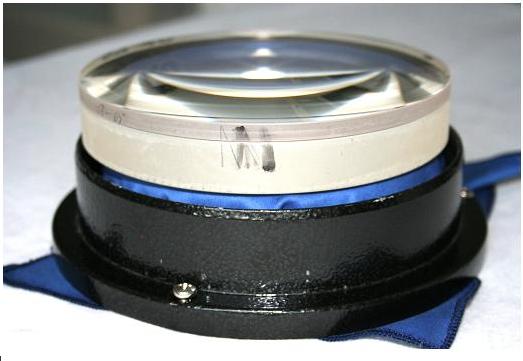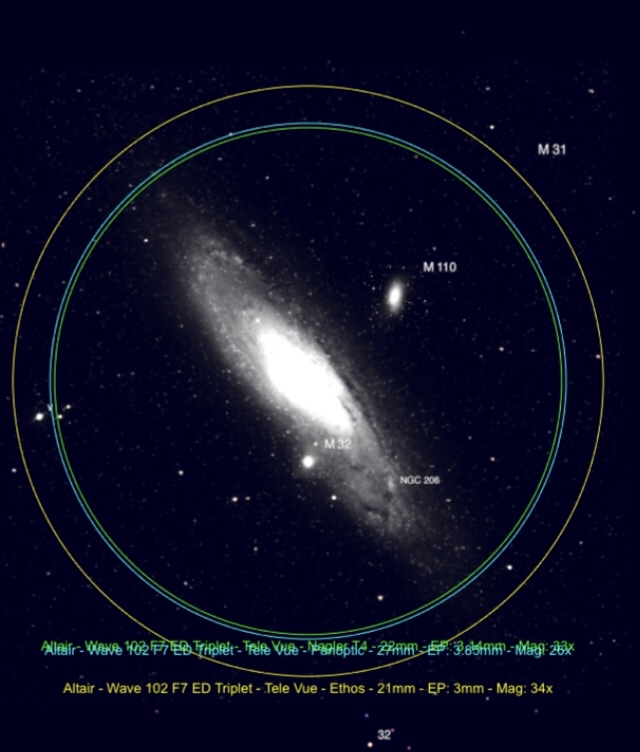-
Posts
53,760 -
Joined
-
Last visited
-
Days Won
455
Content Type
Profiles
Forums
Gallery
Events
Blogs
Posts posted by John
-
-
Thinking further on this, I wonder if the upgrade paths for visual instruments can go down a couple of routes:
- better quality views of generally the same targets
- the potential to see things that could not be seen be seen before.
Both have their attractions and when you have reached as far as you want or can on one route, you can switch to the other one.
Both can be very costly !
I've been down both paths and switched between them quite often as well

-
 1
1
-
-
Nice report !
M101 and M33 are big face on spirals so their surface brightness is much, much lower than the integrated magnitude figure (the ones quoted for them) might suggest. Harder to see than the brighter galaxies such as M81, M82 M51 etc and very easily washed out by any LP in the sky.
-
 1
1
-
-
1 minute ago, pedromreis said:
Yes, sometimes is better to have 1 recommendation instead of 20

I have this book ordered, will arrive sometime next week https://www.cambridge.org/pt/academic/subjects/physics/amateur-and-popular-astronomy/turn-left-orion-hundreds-night-sky-objects-see-home-telescope-and-how-find-them-5th-edition?format=SP&isbn=9781108457569
This is enough for now right?
That's a good one to get you started in finding a range of targets.
Apps like Stellarium and Sky Safari can also be very useful. I use the free PC software version Stellarium and another one called Cartes du Ciel a lot.
-
 1
1
-
-
3 minutes ago, pedromreis said:
Hi
What will a Pocket Sky Atlas give you more than all the apps that you can have on your tablet?
For me, yes, because I don't use a mobile or tablet for astronomy.
What I've done in this thread is just to summarize what my 35+ years in the hobby have taught me works best for me and the lessons that I draw that I would apply if starting out again. I think that was the question you asked ?
Other folks will have been on different journeys and will have different experiences to bring to your thread with different recommendations as you have seen. Some recommend this or that and some are saying that they would not go down that route at all.
You are getting a mix of experiences and preferences.
I guess the challenge for you is to pick your way through all this to decide what you invest in to get the most satisfying results for yourself, this time around.
Sometimes these threads generated almost too much information perhaps (in a very well meaning way course !)

You can end up suffering from "paralysis from analysis" which I've seen happen quite a few times in such threads.
Good luck in finding your way though

-
 1
1
-
-
1 hour ago, pedromreis said:
The eyepieces are one diameter only right? 1,25 or 2.
Whats the purpose of those filters? Point me to a link plz.
What pocket sky atlas you recommend?
Tks!
I would go for 1.25 inch eyepieces to get up and running. 2 inch eyepieces will give a wider field of view but to start with a 30mm plossl will do fine for low power observing.
The filters I mention enhance the contrast of nebulae. This is a really good one:
https://www.firstlightoptics.com/astronomik-filters/astronomik-oiii-filter.html
The atlas I recommend is the Sky & Telescope Pocket Sky Atlas:
-
 1
1
-
-
Great image !
The seeing here was very good for a change and my 100mm Tak was showing those crinkley edges to the dark areas and the dark curved mass to the north. The south polar cap looked like a bright white button.
Nice to see these features imaged

-
I've had a few decent views of Saturn and Jupiter over the past few months but on the whole the views are not as good as I can recall when these planets have been higher in the sky. I'm not really making observing them a priority this year because I know I've had better in the past.
Mars has been pretty good though and this opposition is providing much better views than the last one did even though Mars is a touch smaller this year. It's altitude is much higher this year which makes a lot of difference I think.
I've found that my smaller aperture scopes (refractors mainly) have been more effective planetary observing instruments than my 12 inch dobsonian although the dob has shown Mars quite nicely at times.
In your case I would not be too quick to blame the scope. A few years back it was said by experienced observers on this forum that the coming years would be a bit lean for planetary observing enthusiasts and I think they were, in the main, correct.
-
 1
1
-
-
It's great to read reports of folks really pushing their equipment and themselves on really challenging targets

I had a look at that area last time out with my 12 inch dob but the transparency was so so and I was not clear that I saw it. There were some suspect hazy patches in the right place though.
Time for a re-visit I think

-
 1
1
-
-
It's a target that keeps on giving as well. Always worth return visits to see what parts of the complex you can see:

-
 6
6
-
-
Yay !!!!

-
 1
1
-
-
I've removed, split and cleaned a few doublets up to 152mm. I would not try a triplet though. These were older scopes bought for not a lot.
It is a delicate process and great care has to be taken getting the lens elements out of the cell. I used the approach below, once the lens retaining ring was removed. That in itself can be tricky as some manufacturers add a couple of spots of cement to the threads to dissuade people from tampering.

The method is to put a good quality optical cloth over a suitable tubular support which is a little smaller than the diameter of the objective. The weight of the cell then allows you to gently push it back evenly from around the objective elements without disturbing them.
The rear of the objective is sitting on the optical cloth.
Sometimes the lens elements stick together which adds to the complexity. Care has to be taken to note the relative position and orientation of the lens elements (hence the markings) and that the foil spacers or spacing ring are / is not damaged, lost or moved. Replacing the foil spacers has risks as well as their thickness and even spacing around the lens circumference determines the air space between the elements which is critical to the performance of the lens.
Once the 4 lens surfaces have been blown, cleaned and then blown again, re-assembly is a carefully performed reverse process. Keeping dust particles out of the lens gap can be challenging during re-assembly.
So it can be done but I hesitate to recommend it really. The ones I've done were cheaply bought used scopes.
I've always found myself very relieved to get the objective back together and in it's cell again !
-
 2
2
-
-
Very useful report in this section Gerry

-
 1
1
-
-
Great report and sketch !
Saw similar views myself earlier. Possibly the best of this martian opposition so far.
That "white button" southern polar ice cap is very distinctive isn't it ?

-
 1
1
-
-
Great report Bill - thanks for the link

This passage especially stood out for me:
".........So my recommendation is that before you venture into the realm of filters to
improve your planetary views, first make sure that you are getting detailed views of planets
without filters, as the filters will not perform any magic making a poor view all of a sudden good
with many details......."So no "magic bullets" then.
-
If I was starting again I would try and get a 200mm aperture scope to start with. A dobsonian would be fine because I'm not going to try imaging.
An experienced and skilled observer can do a lot with a 100mm aperture scope but when starting out I was not experienced or skilled so the "helping hand" of some decent aperture is very valuable in getting some satisfying views early on.
I would also invest in a red dot / illuminated reticule finder such as the Telrad or Rigel Quikfinder to complement (rather than replace) the optical finder that comes with the scope.
I would budget to replace the stock eyepieces with decent upgrades such as BST Starguiders, Baader Classic Orthos or Vixen NPL plossls which cost around £50 each.
I would buy a cheshire collimation eyepiece rather than a laser collimator and learn how to use the cheshire with the scope.
I would also invest in the Sky & Telescope Pocket Sky atlas.
If I had any money left I would buy an O-III or UHC filter.
Forums such as Stargazers Lounge were not around when I started out but since they are now, I would join and absorb as much as possible from the folks who are following a similar path to where my interests lay

-
 13
13
-
 2
2
-
-
It might be a local effect.
I've just been observing Mars and it's colours looked OK to me. Very nice views actually - some of the best so far this opposition.
-
 1
1
-
-
1 minute ago, pedromreis said:
Not working for me....
Not for me either now.
I'll see if I can find a working link to this.
-
 1
1
-
-
Transparency is not too good here tonight so it's not a good "veil night".
-
15x70 can be hand held for short periods. 20x80 not so much, unless you are very strong

-
-
These extended deep sky objects are best observed at low magnifications. Not too low or the exit pupil gets too large and any LP issues are made worse.
I find 31mm - 21mm 2 inch eyepieces with very wide fields of view work well. My 40mm 2 inch is less effective because I have some LP issues to contend with.
In terms of magnifications, 21x - 75x depending on the scope I'm using.
-
 2
2
-
-
-
Definitely worth a go with the Heritage 130.
The first time I ever saw the Veil was with a 100mm f/9 refractor, a 24mm 70 degree eyepiece and the Baader UHC-S filter. That filter is not the best by any means but it did the trick. Full blown UHC's are better and a decent O-III the best on this I've since discovered.
-
 1
1
-
-
1 hour ago, markse68 said:
Just ordered one so keep your eyes open for a bargain in the classifieds...or not 😆
That's what I was hoping for

-
 1
1
-












Sky-Watcher Evostar 100ED mount and tripod advice
in Discussions - Scopes / Whole setups
Posted
I was not too happy with my ED120 on the AZ4 even with a 2 inch steel legged tripod. The scope can handle very high magnifications but the mount could not keep up.
The AZ4 was entirely happy with my 102mm F/6.5 Vixen ED refractor on it even with the 1.75 inch steel tubed legs. I can't recall ever using an F/9 100mm on the AZ4 so it might be OK with a good set of tripod legs under it.